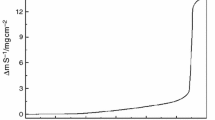Abstract
The present work examined the gas evolution on a solid-state sintered silicon carbide material (EKasic®D) at high anodic potentials (up to 120 V vs Ag/AgCl). By using the amperometric detection as well as the method of oxygen quenching, the part of anodic evolved oxygen could be determined for 75–95% of the total amount of consumed charge. The minor part of the total charge is consumed by oxide film formation (passive range) or material dissolution (transpassive range).












Similar content being viewed by others
References
Schmalzried C, Schwetz KH (2010) Silicon carbide and boron carbide based hard materials. In: Chen RC (ed) Ceramic Science and Technology, vol 2010. Wiley VCH, pp 131–225
Knoch H, Fundus M (1995) Sintered silicon carbide for slide bearings and seal rings. Sealing Technology 17:6–14
Andrews A, Herrmann M, Sephton M, Machio C, Michaelis A (2007) Electrochemical corrosion of solid and liquid phase sintered silicon carbide in acidic and alkaline environments. J Eur Ceram Soc 27:2127–2135
Schneider M, Safonow E, Junker N, Schubert N, Michaelis A (2017) Electrochemical machining of a solid-state sintered ceramic – a parameter study. Int J Refractory Metals & Hard Materials 68:19–23
Samant AN, Dahotre NB (2009) Laser machining of structural ceramics—a review. J Eur Ceram Soc 29:969–993
Srinivasu DS, Axinte DA, Shipway PH, Folkes J (2009) Influence of kinematic operating parameters on kerf geometry in abrasive waterjet machining of silicon carbide ceramics. Intern. J. Machine Tools and Manufacture 49:1077–1088
Datta M (1993) Anodic dissolution of metals at high rates. IBM J. Res. Dev. 37:207
Schneider M, Lohrengel MM (2017) Electrochemical machining. In: Swider-Lyons K (ed) Breitkopf C. Springer-Handbook of Electrochemical Energy. Springer, pp 941–971
Casady JB, Johnson RW (1996) Status of silicon carbide (SiC) as a wide-bandgap semiconductor for high-temperature applications: a review. Solid-State Electronics 39:1409–1422
Schneider M, Schubert N, Michaelis A (2017) Anodic dissolution of solid-state sintered silicon carbide at high current densities. Mat Corr 68:645–650
Moehring A (2004) Entwicklung einer elektrochemischen Durchflusszelle zur Untersuchung des Elektrochemische Senkens (ECM, Electrochemical Machining). dissertation thesis, H-H-Universität Düsseldorf (in German).
Lohrengel MM, Rosenkranz C, Klüppel I, Moehring A, Bettermann H, Van den Bossche B, Deconinck J (2004) A new microcell or microreactor for material surface investigations at large current densities. Electrochim Acta 49:2863–2870
Schubert N, Schneider M, Michaelis A (2013) The mechanism of anodic dissolution of cobalt in neutral and alkaline electrolyte at high current density. Electrochim Acta 113:748–754
Danneel HL (1897/98) Über den durch diffundierende Gase hervorgerufenen Reststrom. Z Elektrochemie 4:227–242
Clark LC Jr, Wolf R, Granger D, Taylor Z (1953) Continuous recording of blood oxygen tensions by polarography. J Appl Physiol 6:189–193
Clark LC Jr (1956) Electrochemical device for chemical analysis. Patent:US2913386
Bard A J, Inzelt G, Scholz F (Eds) (2008) Electrochemical Dictionary. 1st ed., Springer-Verlag.
Müller OH (1947) Polarographic study with a microelectrode past which an electrolyte is flowing. J Am Chem Soc 69:2992–2997
Wolff C-M, Mottola HA (1977) Nonmembrane amperometric sensor for dissolved oxygen in flow- through systems. Anal Chem 49:2118–2121
Fritz JS, Gjerde DT (2009) Ion Chromatography, 4th edn. Wiley-VCH, Hoboken
Junker N, Schneider M (2017) An electrochemical approach to determine the oxygen production during ECM. Proc 13th International Symposium on Electrochemical Machining Technology INSECT, Dresden 75–80.
Walther B (2008) Produktanalyse beim Electrochemical Machining (ECM) von Ti basierten Hartmetallen. Dissertation thesis, H-H-Universität Düsseldorf
Rataj K, Hammer C, Walther B, Lohrengel MM (2013) Quantified oxygen evolution at microelectrodes. Electrochimica Acta 90:12–16
Peterson JI, Fitzgerald RV, Buckhold K (1984) Fiber-optic probe for in vivo measurement of oxygen partial pressure. Analytical Chemistry 56:62–67
Carraway ER, Demás JN, DeGraff BA, Bacon JR (1991) Photophysics and photochemistry of oxygen sensors based on luminescent transition-metal complexes. Anal. Chem. 63:337–342
Vander Donckt E, Camerman B, Herne R, Vandeloise R (1996) Fibric-optic oxygen sensor based on luminiscence quenching of a Pt(II) complex embedded in polymer matrices. Sensors and Actuators B32:121–127
Sydow U, Schneider M, Herrmann M, Kleebe H-J, Michaelis A (2010) Electrochemical corrosion of silicon carbide ceramics. Mat Corr 61:657–664
Sydow U, Sempf K, Herrmann M, Schneider M, Kleebe H-J, Michaelis A (2013) Electrochemical corrosion of liquid phase sintered silicon carbide ceramics. Mat Corr 64:218–224
Schneider M, Yezerska O, Lohrengel MM (2008) Anodic oxide formation on AA2024:electrochemical and microstructure investigation. Corr. Eng. Sci. Technol 43:304–312
Lohrengel, M M, Untersuchungen der elektrochemischen Deckschichtkinetik mit Transientenmethoden, Habilitation thesis, H-H-Universität Düsseldorf 1999 (in German).
Srivastava JK, Prasad M, Wagner JB (1985) Electrical conductivity of silicon dioxide thermally grown on silicon. J. Electrochem. Soc. 132:955–963
Schatt W (Ed) (1983), Einführung in die Werkstoffwissenschaft, Dt. Verlag für Grundstoffindustrie Leipzig (in German).
Hassel AW, Lohrengel MM, Schultze JW (1996) Ultradünne Aluminiumoxidschichten. Metalloberfläche 50:19–22 (in German)
Hasegawa H, Arimoto S, Nanjo J, Yamamoto H, Ohno H (1988) Anodic oxidation of hydrogenated amorphous silicon properties of oxide. J electrochem Soc 135:424–431
Kim KJ, Eom J-H, Kim Y-W, Seo W-S (2015) Electric conductivity of dense, bulk silicon-oxycabide ceramics. J Eur Ceram Soc 35:1355–1360
Author information
Authors and Affiliations
Corresponding author
Additional information
Publisher’s note
Springer Nature remains neutral with regard to jurisdictional claims in published maps and institutional affiliations.
Rights and permissions
About this article
Cite this article
Schneider, M., Šimůnková, L., Junker, N. et al. Quantitative detection of anodic oxygen evolution on solid state sintered silicon carbide under near ECM conditions. J Solid State Electrochem 24, 207–215 (2020). https://doi.org/10.1007/s10008-019-04479-z
Received:
Revised:
Accepted:
Published:
Issue Date:
DOI: https://doi.org/10.1007/s10008-019-04479-z




